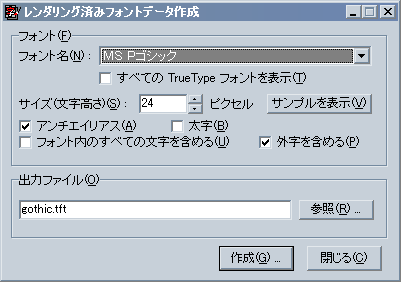
When the rendered font data creation tool (krkrfont.exe in the tools folder) is executed, the above screen is displayed.
- "Font name"
- Specify the font name from which the rendered font data is created. To create a font for vertical writing, select a font with an @ symbol at the beginning.
- "Show all TrueType fonts"
- If not checked, only fonts whose character type is Japanese will be listed in "Font Name", but if checked, all TrueType fonts will be displayed.
- "Size (character height)"
- Specify the size (character height) of the rendered font to be created in pixels.
- "Anti-aliasing"
- Specify whether to perform anti-aliasing. Performing anti-aliasing makes the font smoother.
- "Bold"
- Specifies whether to make it bold. This can be checked only on Windows NT OS (NT4, 2000, XP, Vista, 7 etc.).
- "Include all characters in font"
- Specifies whether to include all characters present in the font. This can be checked only on Windows NT type OS (except NT4).
If checked, all characters contained in the font will be output.
If not checked, only characters that correspond to Shift JIS and half-width alphanumeric characters / kana are output.
NoteThe behavior when unchecked depends on the locale where this tool operates. Normally, when running on a Japanese version of Windows, only characters that correspond to Shift JIS are output. (I do not know because the author does not have anything other than the Japanese version of Windows)
- "Include external characters"
- Specify whether to include external characters. This can be selected only on Windows NT OS (except for NT4). In other OS, it is always checked.
Gaiji characters can be created with the "Gaiji character editor" that comes with Windows. - "sample"
- Displays a sample of the rendered font created by the selected condition. In this "sample" you can see all the characters that will be output.
- "Output File"
- Specify the file to output. The extension of the output file is .tft. Click "Browse" to specify the file in the dialog box.
- "Create"
- Create a rendered font file.
- "close"
- Exit this tool.